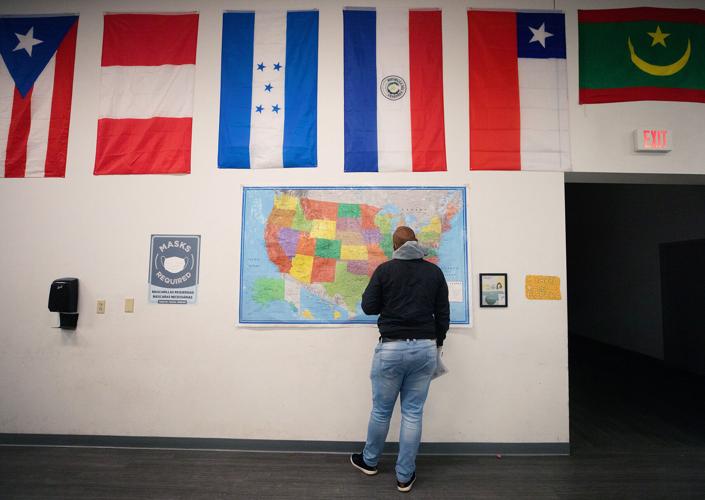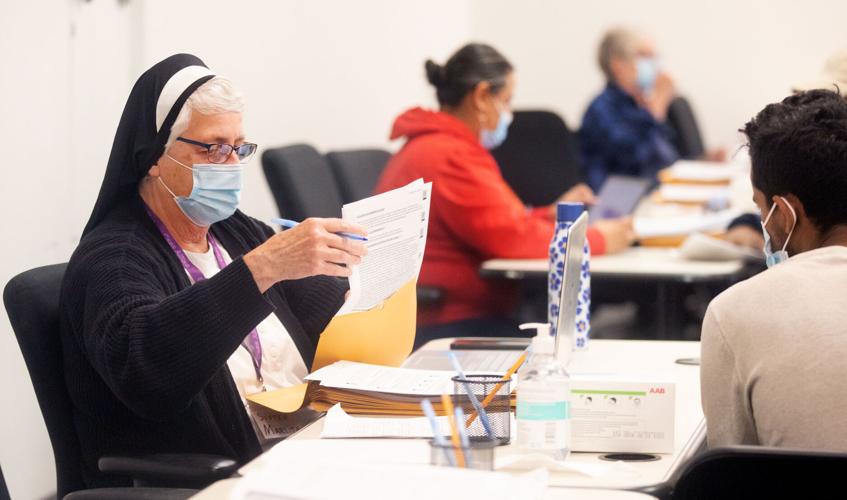As federal funds for Southern Arizona’s migrant-aid network inch closer to depletion, aid workers in Tucson are scrambling to ensure the most vulnerable migrant arrivals can access temporary respite and support services even after those funds are gone at the end of March.
The clock is ticking, said Diego Piña Lopez, director of Casa Alitas, a program of the nonprofit Catholic Community Services. The migrant-aid center’s work has been the bedrock of Pima County’s so-far successful effort to prevent unsheltered street releases of migrants after they’ve been processed and released from Border Patrol custody.
“I’m trying to pull every rabbit out of the hat that I have, and then find new rabbits,” Piña Lopez said. “Now, it’s all dependent on the funding and donations we’re receiving from the community.”
Casa Alitas staff are reaching out to its nearly 800 current and former volunteers to ask for support, Piña Lopez said. He’s also scrutinizing details, like how many blankets a family can receive and what kinds of meals are offered, to maximize the number of people served with donated funds and goods.
Staff are reaching out to local hotels to solicit donated blankets, and asking volunteers with sewing skills to convert the blankets into lightweight bedding for the shelters’ cots, he said.
“It’s a collaboration between a lot of partners to see, how can we do things the most cost-effectively on this shoe-string budget?” he said.
With enough funding, Casa Alitas’ Welcome Center on Ajo Way could temporarily shelter about 140 of the 500 migrants who are expected to be released daily in Tucson by Border Patrol, if current arrival trends hold, county officials said.
Casa Alitas leaders, who have already notified staff to expect 30 layoffs, are figuring out whether they’ll also be able to continue leasing their 400-bed Drexel facility from Pima County.
Most of the arriving migrants only stay in Tucson for one or two nights before they travel to join family or sponsors elsewhere in the country. They get a rest, shower, medical care and other supports during their stay at Casa Alitas.
The priority will be providing overnight shelter for the most vulnerable, Piña Lopez said, including young children and pregnant women.
“My goal is that no child under 10 is street released,” he said.
So far, the response from the Southern Arizona community has been heart-warming, Piña Lopez said, referencing the final scene in the 1946 classic film, “It’s a Wonderful Life.”
“I definitely feel like I’m overflowing with community’s love and compassion,” he said. “I feel like it’s a ‘It’s a Wonderful Life’ moment, where I see the hat on the table and people coming by the house and dropping off whatever they can to help make it work.”
Border communities
Border agents are expected to continue releasing about 500 migrants per day in Cochise and Santa Cruz counties, after federal funding winds down at the end of March, a county memo said.

A migrant looks at a map of the United States at Casa Alitas Drexel Center in Tucson, Ariz., on Jan. 5.
Currently, those migrants can access state-contracted buses to reach support services and travel options in Pima County, but that will stop once Pima County halts its coordination of the region’s migrant-aid system at the end of March.
“Every city that relied on Pima County before is going to have to deal with their own” street releases, said Pima County Supervisor Adelita Grijalva. “Unfortunately, now the community is going to feel and truly understand what it is Pima County has been doing for the past five years.”
Since 2019, the Tucson region’s migrant-aid coalition has used $65 million in mostly federal funding to temporarily assist more than 400,000 legally processed migrants.
This month the Tucson City Council and Mayor Regina Romero will discuss options to help mitigate the consequences of unsheltered street releases in Tucson, including looking at possible ways to extend the April 1 deadline, said city spokesman Andy Squire.
On Feb. 21, the county’s Board of Supervisors voted against committing county general funds to the migrant-relief effort, which officials say is a federal issue that requires federal funding.
Even an “incredibly stripped-down version” of the migrant-aid services would have cost the county $250,000 per month, Grijalva said. The level of services provided now, with federal funds, costs more than $1 million each week.
Emergency managers in those small rural communities are also searching for strategies to mitigate the humanitarian fall-out of migrants arriving to small border towns with minimal transportation and temporary shelter services.
“It is a concern for every single emergency management office in Southern Arizona,” said Sobeira Castro, director of emergency management for Santa Cruz County. The county has been receiving 300 to 500 legally processed migrants per day from border agents, down from a peak of closer to 800 late last year, she said.
Castro said she’s concerned about those who arrive with only the clothes on their back, or without any way to charge their cell phones, if they have them, to contact their families or sponsors in the U.S. While some have their own resources, others won’t be able to afford the $15 bus to Tucson, and the only shelter in Nogales has a capacity of about 20, she said.
Cochise County Sheriff Mark Dannels told the Star he plans to reach out to U.S. Customs and Border Protection leadership about the impending street releases, and will push them to concentrate those releases on bigger cities, rather than Douglas, Bisbee and Naco.
Dannels said releasing newly arrived migrants without supports and leaving them to survive on their own is “inhumane” and unfair to locals.
“Let’s face it, this is a federal problem with our international border that needs their funding, their input, their leadership,” he said. “And right now, I’m not seeing that.”
Disinformation booming
Local law enforcement has been alarmed by rising hostility toward immigrants and those who help them, especially as right-wing media has escalated its attacks on non-government organizations, or NGOs, like Catholic Community Services and humanitarian-aid workers who provide life-saving aid to migrants on the border, falsely accusing them of engaging in human trafficking.
Some are also seizing on instances of crimes committed by immigrants to sow fear about the population as a whole, and falsely refer to legally processed migrants as “illegals.” In reality, migrants are in the country legally once they are processed and released by border agents with a court date. The overwhelming majority of asylum seekers show up for their immigration court hearings, according to the American Immigration Council.
“Once they are released from custody, they are free to go on into the U.S. wherever their final destination may be,” said Colleen Putzel-Kavanaugh, associate policy analyst at the Migration Policy Institute, or MPI, and co-author of a January report detailing recommended reforms to the U.S. immigration system. In researching the report, the authors interviewed U.S. border agents and port-of-entry officers in six border sectors.
“Every Border Patrol agent we talked to said the work these NGOs do is extremely helpful, because that means they’re not dropping people off without services,” she said.
MPI researches will be closely observing the situation in border communities facing a loss of federal funds that supported NGOs’ work.
“It’ll definitely be top of mind, especially considering that one of our report’s recommendations was to strengthen the relationship between NGOs and CBP,” she said.
Pima County Sheriff Chris Nanos said he’s noticed an increase in “fear-mongering” efforts to link migrants to criminal activity. But he’s more concerned about the well-being of migrants themselves than about any risk they might pose to the community.
Vulnerable people will be exposed to the elements as temperatures begin warming, and an increasing number of arrivals don’t speak English or Spanish, he said.

John Modlin, chief of the Border Patrol’s Tucson sector.
“We’re going to be in uncharted waters. One of the biggest fears we have is the safety of migrants,” he said. “You can imagine yourself being dropped in the middle of a city, in a nation as large as ours, and you don’t speak any of the languages. It’s a great risk to be doing this.”
Studies consistently dispel the myth of immigrants as dangerous, said Austin Kocher, a research assistant professor with the Transactional Records Access Clearinghouse, a Syracuse University research institute.
“I’ve never seen a research study that shows that immigrants commit crimes at higher rates than Americans,” he said. “They all show the opposite, that immigrants commit crimes at lower rates than U.S. citizens.”
Local officials are also braced for any security issues stemming from armed vigilantes, who target migrants and humanitarian-aid workers on the border.
“We have these wannabe-Border Patrol people that are patrolling our border thinking they have the legal right to do so, driving around with big trucks asking people for their papers,” Pima County Supervisor Grijalva said. “I’m very concerned that if we have a vulnerable population (of migrants on the streets), that we might start getting people that want to capitalize on that, by pretending to have some sort of legal authority that no one has given them.”
Cochise County Sheriff Dannels said he hasn’t heard any specific threats against migrants, but he discourages anyone from “taking the law into their own hands, unless someone is trying to break into their house.”
“Trust us with the disciplines of the law,” he said. “We’re all in this together, and we got their backs.”
Border Patrol targeted
Some right-wing commentators are directing their ire at border agents who are processing and releasing migrants to NGOs like Casa Alitas, falsely accusing them of complicity in human trafficking or so-called “open-borders” policies.
“Once someone is across that line, they’re in the United States and an agent does not have the ability to just somehow get them back across the line,” John Modlin, chief of Border Patrol’s Tucson sector, said in a Feb. 29 interview with the Arizona Daily Star. “At that point, all of the legal processes need to take place.”
Agents are now encountering 1,700 to 1,800 migrants a day in the Tucson sector, and Modlin expects that figure to reach more than 2,200 a day by April.
Modlin said border agents get criticism from the left on humanitarian grounds — which he says discounts the life-saving work of border agents who rescue migrants in the field — and now, they’re getting vilified by some on the right-wing for doing their jobs.
“I’ve been doing this 28 years and it is kind of the first time you see that sort of attack on multiple fronts,” he said. “Some people saying that we are somehow complicit in this (surge of migrants claiming fear) and others saying there’s no humanity in the patrol.”
Modlin said migrants who turn themselves in to agents are taken to processing centers where they undergo biometric checks, like fingerprinting and facial scans, to screen for criminal histories in the U.S. They’re also cross-referenced with terrorism watch lists.
About 1% of migrants encountered by agents have a significant criminal history in the U.S., he said.
When agents identify someone with a criminal history, they’re held in custody and turned over to the U.S. Marshals Service. If someone’s name shows up on a watch list, they’re held as agents contact the federal Joint Terrorism Task Force and CBP’s National Targeting Center in D.C., he said.
While foreign criminal databases are difficult to access, in rare instances Border Patrol will get international alerts on an individual wanted in another country, he said.
Modlin says, while he understands concern about the vetting process, he’s more worried about the potential bad intentions of those who seek to evade border agents, rather than the migrants who voluntarily turn themselves in.
“The thing that bothers agents the most is knowing that people are getting away from us and not knowing what that person’s intent was, while we’re dealing with groups (who self-surrender) that for the most part don’t pose a threat,” he said.
More asylum officers and immigration judges to process asylum requests and more detention space would help free up agents to focus on their primary mission of finding migrants trying to evade agents and interdicting criminal activity, he said. Properly resourcing the immigration system would also improve security, he said.
“If the system was equipped to handle what we’re dealing with, then there would be more time to do more thorough checks, thorough interviews and investigations,” he said. “That can’t be entirely on the Border Patrol. The system in all of this needs to expand commensurate to what we’re doing.”
Immigration experts say legal avenues to immigrate to the U.S. — either through the country’s out-of-date work-visa programs, or the overwhelmed asylum system — are impossible for most to access.
Opening up more legal immigration pathways would also take power away from Mexican criminal groups, who are profiting from lucrative human-smuggling operations that exploit the lack of legal options to immigrate, advocates say.
Asylum seekers in Nogales, Sonora are waiting up to six months for an appointment through the Biden Administration’s CBP One application. And they’re waiting in dangerous conditions, vulnerable to kidnapping, extortion and assault by criminal groups and corrupt officials, aid workers in Nogales, Sonora and human-rights advocates say.
Some get desperate enough to turn to human smugglers, just to reach U.S. soil so they can turn themselves in and request asylum.
Federal funding
Pima County Administrator Jan Lesher wrote in a Feb. 16 memo to supervisors that due to gridlock in the U.S. Congress, the chance of renewed federal funding before April is “negligible, if not zero.”
Still, Arizona U.S. Sens. Kyrsten Sinema and Mark Kelly sent a letter to colleagues on Tuesday, pressing Congress to give an additional $752 million in federal funds for the Shelter and Services Program, which has funded the migrant-relief effort in border communities, “to avoid a catastrophic situation,” the senators wrote.
At a Feb. 21 border roundtable in Douglas, Arizona, Sinema told local officials that the humanitarian crisis facing border communities isn’t necessary; it’s a choice Congress has made by refusing to act.

Sister Marlita Henseler helps a migrant with his paperwork during the intake process at Casa Alitas Drexel Center in the southwest area of Tucson in 2023.
The bipartisan border-security package, co-sponsored by Sinema, would have provided $1.4 billion in continued federal funding for the migrant-relief effort. Within hours of its release on Feb. 4, GOP legislators called the bill “dead on arrival” and days later the Senate voted to kill the bill before considering it.

A border agent tosses a backpack to a migrant awaiting processing at a staging area near Lukeville, 150 miles southwest of Tucson, in this 2023 photo.
“We could have avoided all of that,” Sinema said, of the expected unsheltered street releases. “Unfortunately, partisans in Washington decided that the border crisis isn’t really a crisis. They decided they don’t really actually want to do anything about it after all. … You all are continuing to manage a crisis that you didn’t create.”
Get your morning recap of today's local news and read the full stories here: tucne.ws/morning









